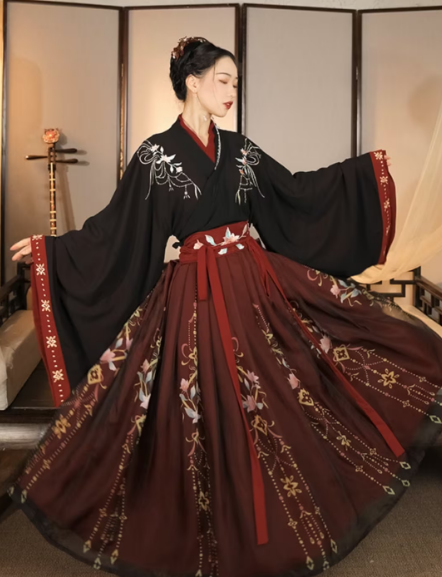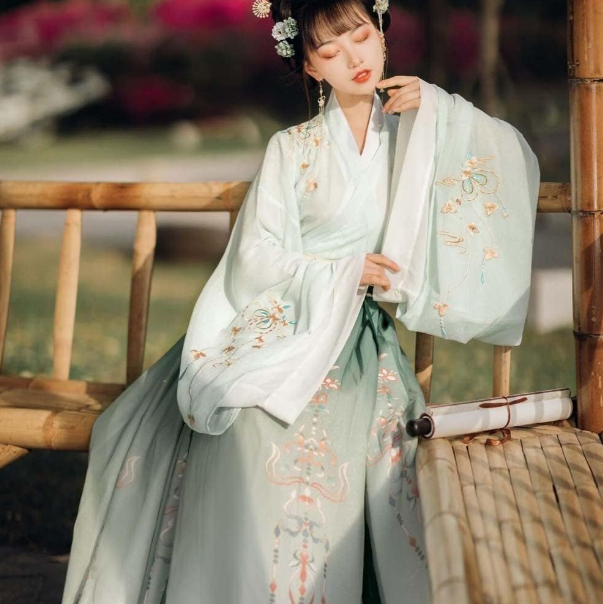Historical Overview of Hanfu
Origins and Evolution
Hanfu, the traditional clothing of the Han Chinese, traces its roots back to the Yellow Emperor’s reign. Legends often cite the Yellow Emperor as a key figure in the development of Hanfu, symbolizing its deep cultural significance. Over time, Hanfu evolved, reflecting changes in aesthetics, functionality, and social norms. Each dynasty introduced distinct styles, fabrics, and colors, shaping Hanfu’s evolution. For example, the Tang dynasty favored wide-sleeved robes and vibrant colors, often highlighted in Silk Road exchanges. This evolution wasn’t just a fashion statement but mirrored broader societal changes and technological advancements in textile manufacturing.

Influence of Dynastic Changes
Each Chinese dynasty uniquely impacted Hanfu’s design, fabric, and decoration. The Shang dynasty preferred dark-colored, narrow-sleeved garments, often made from silk, indicating the early development of sericulture. Hanfu during the Zhou dynasty saw the incorporation of layered clothing, reflecting social hierarchies and norms. The Han dynasty, for which Hanfu is named, popularized shenyi, a one-piece robe symbolizing unity and modesty. In contrast, the Ming dynasty’s Hanfu became more structured, emphasizing form and ceremony, with rigid collars and straight sleeves. These dynastic influences reveal Hanfu’s adaptability, directly correlating with the political, social, and economic climates of the times. Each period’s Hanfu also held specific standards regarding material quality and garment construction, emphasizing the craftsmanship and skill of ancient Chinese textile artisans.
Basic Components of Hanfu
Upper Garments (Ru)
Ru refers to the upper garments in Hanfu, primarily consisting of a shirt or a jacket. These garments vary significantly in style, sleeve length, and decorations based on gender, status, and occasion. Men typically wear a zhongdan (a type of central-buttoned jacket) or a yishang, a longer, more formal overcoat. Women’s Ru, on the other hand, often feature flowing sleeves and intricate embroidery, emphasizing elegance and grace. Materials used range from fine silks for the affluent to simpler cotton and linen for the common people. These garments not only provide insights into the wearer’s social status but also reflect the artistic sensibilities and skills of ancient Chinese weavers and embroiderers.
Lower Garments (Ku)
Ku encompasses a variety of lower-body garments, such as skirts, pants, and wraps. In ancient times, both men and women preferred long skirts, signifying elegance and a sedentary lifestyle. Pants or trousers, usually made of durable materials like cotton or hemp, became popular for practical reasons among those who needed more mobility, such as horsemen and laborers. The width, fabric, and color of these garments could indicate the wearer’s occupation, social ranking, and even marital status. Hanfu skirts often feature high waists and pleats, allowing ease of movement while maintaining an aesthetic of modesty and refinement. The choice of fabric — from luxurious silks to humble linens — and the quality of workmanship directly speak to the garment’s purpose, whether for daily wear, ceremonial occasions, or as a symbol of status and identity in ancient Chinese society.
Varieties of Hanfu Styles
According to Dynasties
The style of Hanfu dramatically varied across different Chinese dynasties, each reflecting unique aesthetics and cultural values. During the Tang Dynasty, for example, Hanfu styles were characterized by their flamboyance, with wide sleeves and vibrant colors, symbolizing the empire’s prosperity and openness. The Song Dynasty favored a more restrained elegance, with Hanfu designs becoming simpler and more practical, mirroring the dynasty’s focus on scholarly pursuits and civil administration. Ming Dynasty Hanfu returned to more intricate designs, featuring stand-up collars and layered clothing, reflecting the era’s renewed emphasis on Confucian orthodoxy and traditional rituals. Each dynasty’s prevailing philosophies, economic conditions, and interactions with neighboring cultures had a direct impact on the evolution of Hanfu styles.
Based on Social Status
Social status in ancient China also significantly influenced Hanfu designs. Nobles and royalty would often wear Hanfu made of high-quality silk with intricate embroidery and multiple layers, showcasing their wealth and status. Officials and scholars had distinct styles, including robes with specific patterns, colors, and insignia that denoted their rank and position. Commoners, constrained by economic factors, generally wore simpler, more practical Hanfu. Their clothes were often made of cheaper materials like cotton or hemp and lacked the elaborate decorations seen in the attire of the upper classes. Even within the same social stratum, age and marital status could influence the style of Hanfu worn, with specific colors and patterns reserved for certain age groups or marital statuses, reflecting the deeply hierarchical and regulated nature of ancient Chinese society.
Accessories and Embellishments
Traditional Jewelry
Traditional jewelry plays a crucial role in Hanfu attire, adding layers of meaning and beauty. Common materials include gold, silver, jade, and pearls, each holding its own cultural significance. For instance, jade symbolizes purity and moral integrity in Chinese culture and often features in the jewelry of both men and women. Women typically adorn themselves with intricate hairpins, necklaces, and bracelets, each piece carefully chosen to complement their Hanfu and status. Men’s jewelry, though generally more understated, also reflects their social standing and personal style. For example, a scholar-official might wear a refined jade pendant to signify his intellectual status.
Headwear and Hair Ornaments
Headwear and hair ornaments are integral to completing a Hanfu ensemble, indicating the wearer’s age, marital status, and even moral character. Women’s headwear ranges from simple hairpins and combs to elaborate coronets for brides and noblewomen. These pieces are often delicately crafted with symbols like flowers, birds, and dragons, each carrying specific connotations within Chinese symbolism. Men’s headwear includes hats and caps that vary with their social ranking and occupation. The type of hat, its size, and the materials used are meticulously regulated, especially for government officials. Scholars often prefer simpler, more scholarly headdresses, aligning with their intellectual and modest image. Hair ornaments not only enhance the beauty and elegance of Hanfu but also serve as a nuanced language of social identity in traditional Chinese attire.
Hanfu in Modern Context
Hanfu Movement and Cultural Revival
The Hanfu Movement, gaining momentum in the early 21st century, represents a resurgence of interest in traditional Han Chinese clothing. Young enthusiasts, inspired by Hanfu’s rich heritage and beauty, are driving this revival. They wear Hanfu in daily life and at cultural events, expressing their identity and reconnecting with Chinese history. This movement goes beyond fashion; it’s a statement about preserving and appreciating traditional culture. It also encourages learning about ancient customs, rituals, and etiquette, fostering a deeper understanding and respect for Chinese heritage.

Contemporary Fashion Adaptations
Contemporary fashion designers are increasingly incorporating elements of Hanfu into modern clothing. This fusion creates outfits that are both stylish and imbued with cultural significance. Designers often experiment with fabrics, patterns, and cuts to blend ancient elegance with modern practicality. The adaptability of Hanfu in contemporary fashion also reflects global influences and changing aesthetic tastes. Designers sometimes mix traditional Hanfu elements, like silk brocades and classic patterns, with Western-style cuts or accessories, crafting garments that appeal to a diverse, modern audience. This trend not only revives traditional arts but also introduces Hanfu to new generations and cultures worldwide.
Rituals and Ceremonies Involving Hanfu
Traditional Festivals and Celebrations
Hanfu plays a central role in traditional Chinese festivals and celebrations, symbolizing respect for customs and ancestral traditions. During the Lunar New Year, people often wear brightly colored Hanfu to symbolize good luck and happiness for the coming year. The Dragon Boat Festival and the Mid-Autumn Festival also see many participants dressed in Hanfu, engaging in age-old rituals and games. Wearing Hanfu during these times connects individuals to their heritage, creating a tangible link to the past. It also adds to the festive atmosphere, enhancing the visual spectacle and cultural significance of these occasions.
Wedding and Formal Ceremonial Attires
In weddings and formal ceremonies, Hanfu represents more than just attire; it embodies blessings, respect, and adherence to cultural rites. Traditional wedding Hanfu for brides often includes a red skirt and an elaborately embroidered top, red symbolizing love and joy in Chinese culture. Grooms typically wear darker, more somber Hanfu, with fine detailing that reflects their family’s status. These outfits are not just about beauty; they also adhere to ancient customs regarding color, fabric, and design. In formal ceremonies, such as the Confucian ‘Coming of Age’ ceremony, Hanfu helps in marking significant life transitions, grounding these events in a deep cultural and historical context.